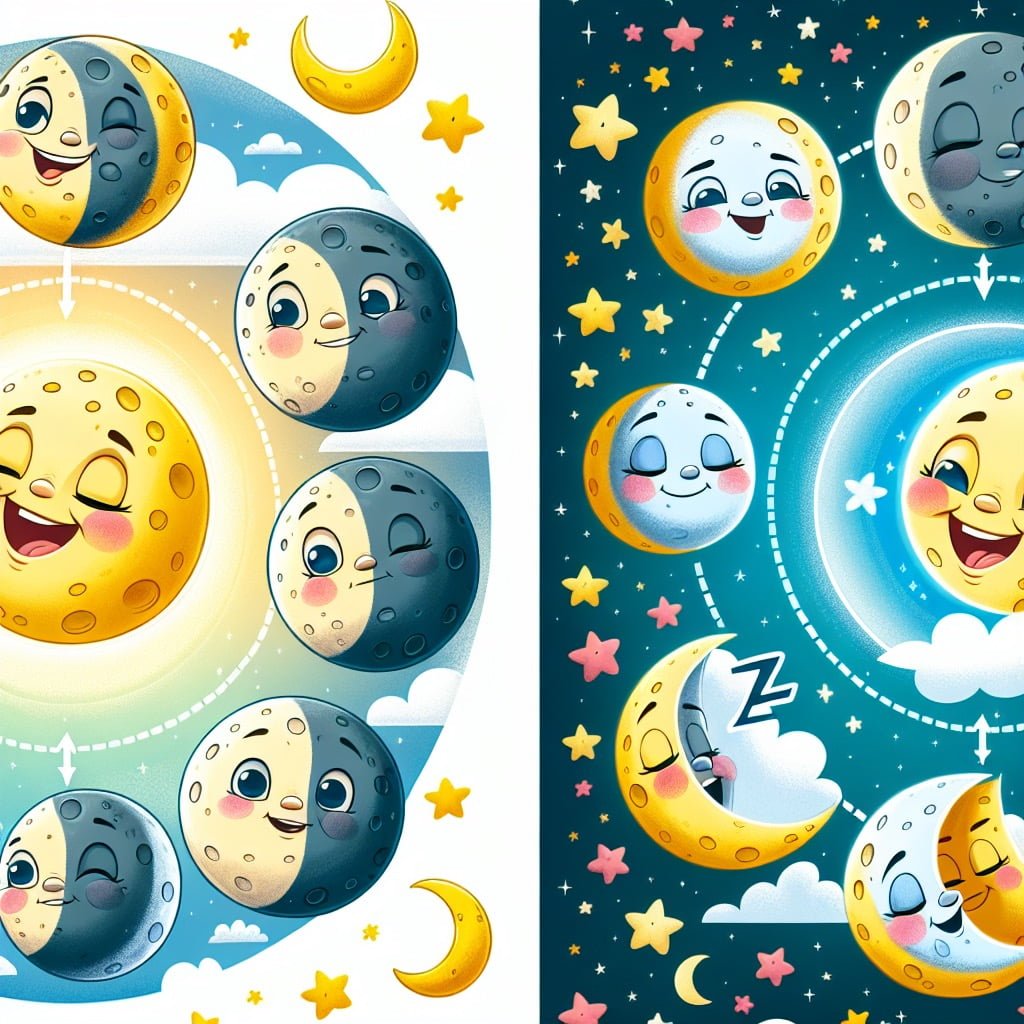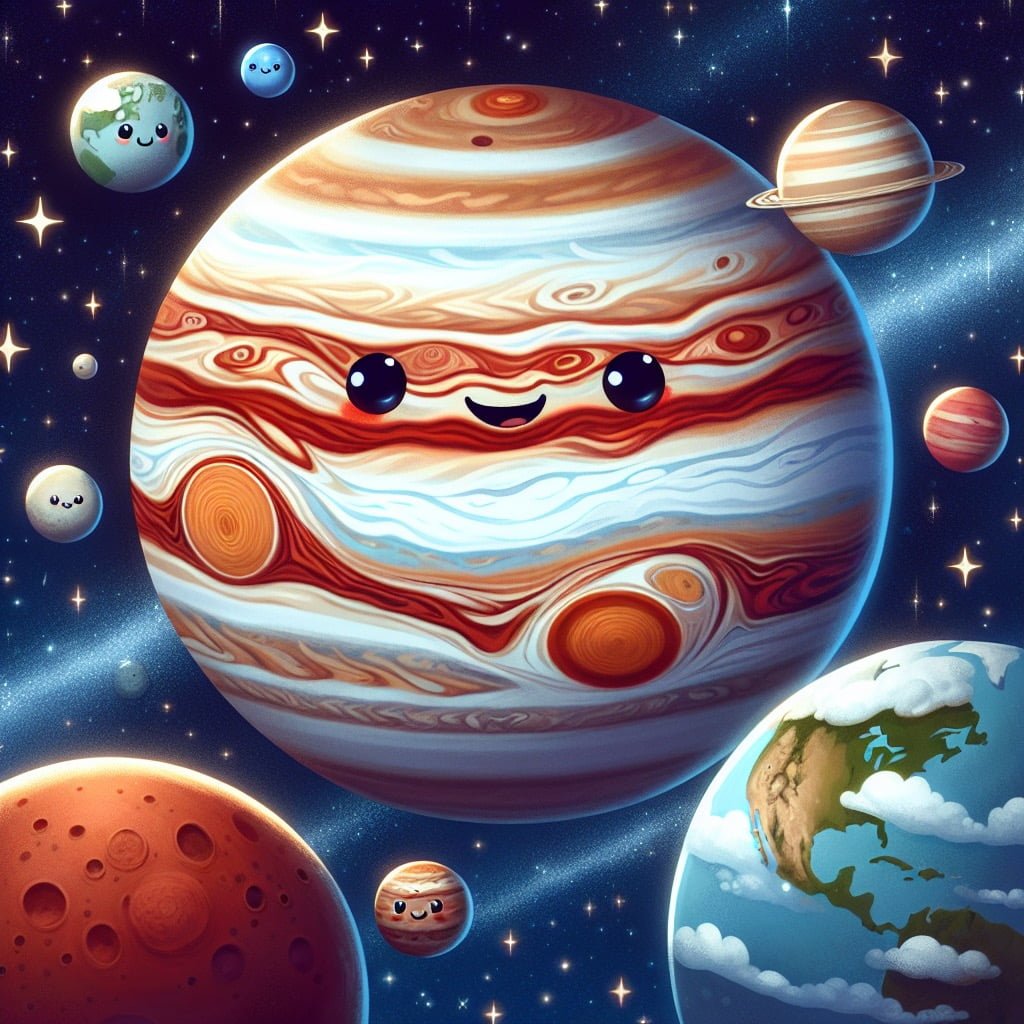Welcome to a fascinating exploration of Astronomy Facts For Kids! Astronomy is a captivating field that allows us to delve into the wonders of the cosmos and understand the universe we live in. In this blog post, we will uncover fun and engaging facts about astronomy that are sure to spark curiosity and ignite a passion for learning about the mysteries of space. From the Sun being a star to the incredible density of neutron stars, each fact will broaden your knowledge and inspire you to continue exploring the vast expanse of the universe. So, join us on this educational journey as we uncover the beauty and complexity of celestial bodies, and encourage a sense of wonder and awe in young minds. Let’s embark on this cosmic adventure together and inspire a new generation of budding astronomers!
Astronomy Facts For Kids
1. The Sun is a Star

For younger kids: The Sun is a big, hot star that gives us light and heat!
For older kids: The Sun is a massive, luminous sphere of hot plasma that generates heat and light through nuclear fusion, making it a star just like the countless others in the night sky.
Detailed explanation:Astronomy Facts For Kids are not only fascinating, but they also provide valuable insight into the universe and our place within it. One of the most fundamental and awe-inspiring Astronomy Facts For Kids is the realization that the Sun, the bright, fiery orb that lights up our sky each day, is actually a star.
In the vast expanse of the cosmos, stars are the building blocks of galaxies, including our own Milky Way. They are massive spheres of gas that emit light and heat through the process of nuclear fusion, where hydrogen atoms are fused together to form helium, releasing a tremendous amount of energy in the process. This energy is what we see and feel as sunlight here on Earth.
The Sun is classified as a yellow dwarf star, belonging to the main sequence of stars based on its size, temperature, and brightness. It is located at the center of our solar system, with its gravitational pull keeping the planets in orbit around it. The Sun’s immense heat and light not only sustain life on Earth but also shape our climate, weather patterns, and environment in countless ways.
By understanding that the Sun is a star, Astronomy Facts For Kids can begin to grasp the sheer scale and complexity of the universe. They can appreciate the interconnectedness of all celestial bodies and the forces that govern their behavior. Studying astronomy can also inspire a sense of wonder and curiosity about the mysteries of the cosmos, encouraging young minds to explore and learn more about the science of the stars.
Astronomy Facts For Kids
2. The Moon Has Phases

For younger kids: The Moon changes shape as the month goes by!
For older kids: The Moon goes through different phases throughout the month, from new moon to full moon and back. These phases are caused by the relative positions of the Earth, Moon, and Sun.
Detailed explanation:One of the most fascinating aspects of astronomy facts for kids is the observation that the Moon has phases. These phases are the result of the Moon’s changing position in its orbit around the Earth, relative to the position of the Sun. As the Moon orbits the Earth, different portions of its illuminated side are visible from our perspective on Earth, creating the appearance of different shapes or phases.
The Moon’s phases begin with the New Moon phase, where the side of the Moon facing us is completely dark because it is not receiving any direct sunlight. As the Moon continues to orbit the Earth, more and more of its illuminated side becomes visible, leading to the Waxing Crescent, First Quarter, Waxing Gibbous, and eventually the Full Moon phase. During a Full Moon, the entire illuminated side of the Moon is visible from Earth.
After the Full Moon, the Moon’s illuminated side begins to decrease in size, leading to the Waning Gibbous, Third Quarter, Waning Crescent, and finally back to the New Moon phase. This cycle of phases repeats approximately every 29.5 days, known as a lunar month.
Understanding the phases of the Moon is not only a captivating aspect of astronomy for kids, but it also serves as a reminder of the interconnectedness of celestial bodies in our solar system. By observing and learning about the Moon’s phases, children can develop a deeper appreciation for the beauty and complexity of the universe.
Astronomy Facts For Kids
3. There Are Thousands of Stars in the Sky

For younger kids: The night sky is full of twinkling stars!
For older kids: On a clear night, you can see thousands of stars in the sky, but in reality, there are billions and billions of stars in the universe, each with its own unique properties and characteristics.
Detailed explanation:Astronomy Facts For Kids are always fascinating, especially when it comes to the vastness of the universe. One of the most mind-boggling Astronomy Facts For Kids is the sheer number of stars in the sky. When we look up at night, we see thousands of twinkling lights, but what we are actually seeing is just a tiny fraction of the stars that are out there in the universe.
To put this into perspective, our Milky Way galaxy alone is estimated to contain around 100 billion stars. And that’s just one galaxy out of the billions that exist in the universe. When we look up at the night sky, we see stars that are light years away from us, meaning that the light we see from these stars took years to reach us.
Astronomy Facts For Kids can help us appreciate the vastness and complexity of the universe. When we look up at the night sky, we are looking back in time, seeing stars that may no longer exist or have already gone supernova. The universe is constantly evolving and changing, with new stars being born and old ones dying.
So next time you gaze up at the night sky, remember that the thousands of stars you see are just a small glimpse of the immense number of stars that exist in the universe. Astronomy Facts For Kids can help us understand our place in the cosmos and appreciate the beauty and wonder of the night sky.
Astronomy Facts For Kids
4. Asteroids Are Space Rocks

For younger kids: Asteroids are like big space rocks that orbit around the Sun!
For older kids: Asteroids are rocky objects that orbit the Sun in the asteroid belt between Mars and Jupiter. They can range in size from small pebbles to large rocks several hundred kilometers in diameter.
Detailed explanation:Asteroids are space rocks that orbit the sun, mainly found in the asteroid belt located between Mars and Jupiter. These rocky bodies are remnants from the formation of the solar system around 4.6 billion years ago. They vary in size from small boulders to massive behemoths hundreds of kilometers in diameter.
Astronomers study asteroids to learn more about the history of our solar system and the potential threats they may pose to Earth. These space rocks are composed of different materials such as metals, silicate rocks, and even ice. By analyzing the composition of asteroids, scientists can gain insights into the conditions present in the early solar system.
One interesting fact about asteroids is that they can sometimes collide with each other, creating even smaller fragments called meteoroids. When these meteoroids enter Earth’s atmosphere, they burn up and create the spectacular light show known as meteor showers.
Astronomy Facts For Kids can be a great way to introduce young minds to the fascinating world of space rocks. Learning about asteroids can spark curiosity and a sense of wonder about the vast universe beyond our planet. By teaching children about asteroids, we can inspire the next generation of astronomers and space explorers.
In conclusion, asteroids are indeed space rocks that play a crucial role in shaping our understanding of the solar system. By studying these rocky bodies, scientists can unlock the mysteries of the cosmos and potentially protect our planet from any potential impacts in the future. Astronomy Facts For Kids are a valuable tool in inspiring a love for science and exploration in young minds.
Astronomy Facts For Kids
5. The Milky Way Is Our Galaxy

For younger kids:The Milky Way is like a big city of stars where we live!
For older kids: The Milky Way is the spiral galaxy that contains our Solar System. It is home to billions of stars, planets, and other celestial objects, and it’s just one of the many galaxies in the universe.
Detailed explanation:Astronomy Facts For Kids are fascinating to learn about, and one of the most intriguing facts is that the Milky Way is our galaxy. The Milky Way is a vast spiral galaxy that contains our solar system, along with billions of other stars, planets, and celestial bodies. It is estimated that the Milky Way is about 100,000 light-years in diameter, making it a massive structure in the universe.
One interesting Astronomy Fact For Kids about the Milky Way is that it is just one of billions of galaxies in the universe. Each galaxy is made up of billions or even trillions of stars, and they come in various shapes and sizes. Some galaxies are spiral-shaped like the Milky Way, while others are elliptical or irregular in shape.
The Milky Way gets its name from its appearance as a milky band of light stretching across the night sky. This band is made up of millions of stars that are too faint to be seen individually with the naked eye. When we look up at the night sky and see the Milky Way, we are actually seeing the disk of our galaxy edge-on.
As we look deeper into the universe, we can see other galaxies similar to our own, each with its own unique characteristics. Studying Astronomy Facts For Kids like the Milky Way helps us understand the vastness and complexity of the universe we live in, and opens our minds to the wonders of outer space.
Astronomy Facts For Kids
6. Comets Have Tails

For younger kids: Comets are like dirty snowballs with a long tail!
For older kids: Comets are small icy bodies that orbit the Sun, and as they get closer to the Sun, the heat causes the ice to turn into gas, producing a bright glowing tail that extends for millions of miles.
Detailed explanation:Comets have long been a fascinating subject in the field of astronomy, especially for kids who are just starting to learn about the wonders of the universe. One of the most captivating features of comets is the fact that they have tails. These tails are not physical structures like a tail on an animal, but are actually made up of gas and dust particles that are released from the comet as it gets closer to the sun.
As a comet travels through space, the heat from the sun causes some of the ice on the surface of the comet to vaporize, releasing gas and dust into the surrounding space. This forms a glowing envelope around the comet called the coma. The pressure of sunlight and solar wind then push the gas and dust particles away from the comet, creating its tail.
There are actually two types of tails that comets can have. The first is called a dust tail, which is made up of heavier particles that reflect sunlight and appear yellow or orange in color. The second type is called an ion tail, which is made up of lighter particles that are ionized by the sun’s radiation and appear blue in color. Both tails can stretch for millions of kilometers behind the comet as it travels through space.
Overall, the presence of tails on comets is a visually striking phenomenon that captures the imagination of astronomers and curious kids alike. Studying comets and their tails can provide valuable insights into the composition of these icy bodies and the processes that govern their behavior in the solar system. Astronomy facts for kids like this one about comets having tails can inspire a lifelong interest in the wonders of the universe.
Astronomy Facts For Kids
7. Venus is the Hottest Planet

For younger kids: Venus is really, really hot!
For older kids: Venus has a thick atmosphere that traps heat, making it the hottest planet in our solar system with surface temperatures hot enough to melt lead.
Detailed explanation:Venus, the second planet from the sun in our solar system, is known for being the hottest planet among all the planets. The average surface temperature on Venus is a scorching 864 degrees Fahrenheit (462 degrees Celsius), making it hotter than even Mercury, which is the closest planet to the sun. This extreme heat is due to the thick atmosphere of Venus, which traps heat from the sun and creates a greenhouse effect. The atmosphere of Venus is primarily composed of carbon dioxide, with clouds of sulfuric acid contributing to the planet’s oppressive heat.
Despite being farther away from the sun than Mercury, Venus experiences higher temperatures because of its thick atmosphere and the greenhouse gases present. The dense atmosphere on Venus creates a runaway greenhouse effect, where the heat gets trapped and cannot escape, causing the planet to continually heat up. This phenomenon has resulted in Venus having surface temperatures hotter than even Mercury, which lacks a substantial atmosphere to trap heat.
For kids interested in astronomy, learning about Venus and its extreme temperatures can be fascinating. Understanding why Venus is the hottest planet in our solar system can provide insight into the importance of atmospheres and greenhouse gases in determining planetary temperatures. By studying planets like Venus, scientists can learn more about the effects of greenhouse gases on climate and how they can impact a planet’s overall temperature. So next time you look up at the night sky, remember that Venus may be beautiful, but it’s also incredibly hot due to its unique atmospheric composition and greenhouse effect.
Astronomy Facts For Kids
8. Neutron Stars are Super Dense

For younger kids: Neutron stars are super heavy and packed really tightly!
For older kids: Neutron stars are the collapsed cores of massive stars, and they are incredibly dense—so dense that a sugar-cube-sized amount of neutron-star material would weigh about a billion tons!
Detailed explanation:Neutron stars are indeed super dense objects in astronomy, packed with an incredible amount of mass in a relatively small volume. These stellar remnants are formed when massive stars undergo supernova explosions at the end of their life cycle. During this explosive event, the outer layers of the star are ejected into space, leaving behind the core of the star, which collapses under its own gravity.
What remains is a neutron star, a celestial body with a mass greater than that of the Sun but compressed into a sphere just a few kilometers in diameter. To put this into perspective, a sugar-cube-sized amount of neutron star material on Earth would weigh as much as a mountain. This extreme density is due to the fact that the protons and electrons in the core of the star are crushed together by gravity, forming a dense mass of neutrons.
One of the most fascinating aspects of neutron stars is their immense gravitational pull. The surface gravity on a neutron star is so strong that if you were to stand on it, you would weigh millions of times more than you do on Earth. This phenomenon is a direct result of the star’s density, where the gravitational force is proportional to the mass of the object and inversely proportional to the square of the distance from its center.
In conclusion, neutron stars are truly remarkable objects in the field of astronomy, showcasing the incredible forces at play in the universe. Their super density and powerful gravitational pull provide a glimpse into the extreme conditions that exist in the cosmos, making them a captivating subject for study and exploration. Astronomy Facts For Kids can help inspire young minds to learn more about these fascinating celestial bodies and the wonders of the universe.
Astronomy Facts For Kids
9. Jupiter has Giant Storms

For younger kids: Jupiter has really big and strong storms!
For older kids: The most famous storm on Jupiter is the Great Red Spot, which has been raging for centuries. This massive storm is larger than the entire Earth!
Detailed explanation:Jupiter, the largest planet in our solar system, is known for its giant storms that rage across its atmosphere. These massive storms can be thousands of kilometers in diameter and can last for long periods of time. The most famous storm on Jupiter is the Great Red Spot, a massive storm that has been raging for at least 350 years. This storm is so large that it could fit three Earth-sized planets within its boundaries.
These storms on Jupiter are caused by the planet’s rapid rotation and its immense size. Jupiter is a gas giant, composed mostly of hydrogen and helium, with no solid surface like Earth. This means that the planet’s atmosphere is constantly in motion, creating the perfect conditions for these massive storms to form.
Studying these storms on Jupiter can provide scientists with valuable insight into the inner workings of the planet and how such storms can form and persist. The study of these storms falls under the field of astronomy, which focuses on the study of celestial objects such as planets, stars, and galaxies. Astronomy Facts For Kids can be fascinating not only for scientists but also for young learners who are curious about the universe and how it works.
In conclusion, Jupiter’s giant storms are a testament to the unique and complex nature of our solar system. By studying these storms, scientists can learn more about the dynamics of gas giants like Jupiter and gain a better understanding of the universe as a whole. Astronomy Facts For Kids can inspire a sense of wonder and curiosity about the vastness of space and our place within it.
Astronomy Facts For Kids
10. The Big Dipper is a Constellation

For younger kids: The Big Dipper looks like a big spoon in the sky!
For older kids: The Big Dipper is actually an asterism, a familiar grouping of stars within the constellation Ursa Major, and it has been used by many cultures throughout history for navigation and storytelling.
Detailed explanation:Astronomy Facts For Kids can be a fascinating and educational topic to explore, especially when discussing constellations like the Big Dipper. The Big Dipper, also known as Ursa Major, is one of the most recognizable and easily identifiable constellations in the night sky. It is composed of seven bright stars that form a shape resembling a dipper or ladle.
Astronomy Facts For Kids can teach them that the Big Dipper is not actually a constellation in itself, but rather an asterism, which is a recognizable pattern of stars within a constellation. In this case, the Big Dipper is part of the larger Ursa Major constellation. Constellations are groups of stars that form imaginary shapes or patterns in the sky, as seen from Earth.
Astronomy Facts For Kids can inform them that the Big Dipper is a circumpolar constellation, meaning it is visible in the night sky year-round for observers in the northern hemisphere. This makes it a popular target for stargazing enthusiasts of all ages. Additionally, the Big Dipper is often used as a navigational tool, as the two pointer stars at the end of the ladle point towards the North Star, Polaris.
In conclusion, Astronomy Facts For Kids can provide valuable information about the Big Dipper and other celestial objects. Learning about constellations like the Big Dipper can inspire curiosity and appreciation for the wonders of the universe. Whether observed with the naked eye or through a telescope, the Big Dipper is a captivating sight that connects us to the vastness of space.
Did You Know?
The Hubble Space Telescope has taken some of the most incredible and detailed images of distant galaxies and nebulae, helping scientists understand more about the universe we live in.
Summary of Astronomy Facts For Kids
Are you ready to ignite your child’s curiosity and inspire a love for learning about the cosmos? Dive into our blog post on Astronomy Facts For Kids, where we explore the wonders of the universe in a fun and engaging way.
By delving into the exciting world of astronomy, kids can not only learn fascinating facts about planets, stars, and galaxies, but also develop important critical thinking and problem-solving skills. Understanding the principles of astronomy can help them analyze data, make connections, and draw conclusions about the nature of the universe, fostering a deeper appreciation for the scientific method.
But that’s not all – studying astronomy can also spark a sense of wonder and awe in kids as they contemplate the vastness of the cosmos and the mysteries that lie beyond our reach. Encouraging your child to explore astronomy facts can inspire them to dream big and consider the endless possibilities of what else may be out there in the universe.
So why wait? Join us on a journey through the fascinating world of astronomy and watch as your child’s imagination soars to new heights. By providing them with the tools to expand their understanding of the universe, you can instill a lifelong love of learning and exploration that will benefit them in all aspects of their lives. Don’t miss out on this incredible opportunity to inspire and educate your child through Astronomy Facts For Kids.
Sources and additional information for Astronomy Facts For Kids
WikipediaBritannicaScienceDirectNatureScientific AmericanNew ScientistNational Science FoundationScience NewsThe Royal SocietyLive ScienceScience MagazinePLOS ONENational Geographic KidsNASALive ScienceScientific AmericanNational Science Foundation (NSF)The Royal SocietyAmerican Association for the Advancement of Science (AAAS)Khan AcademyExploratorium




